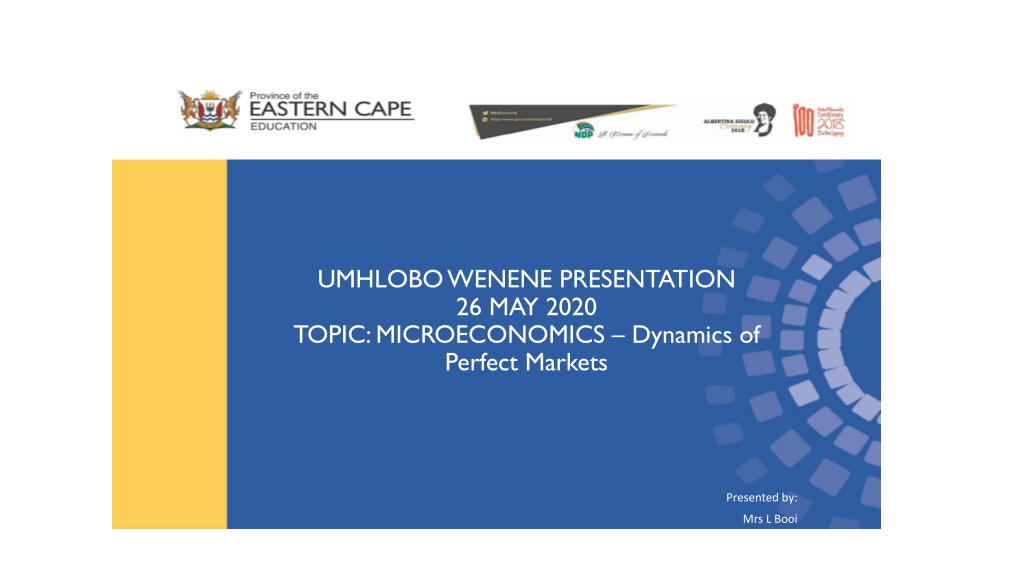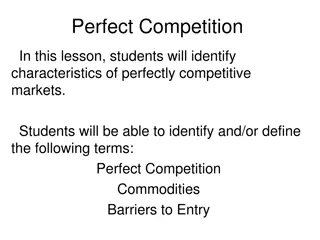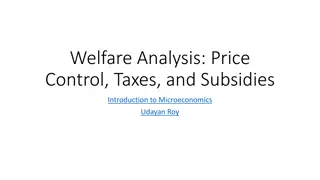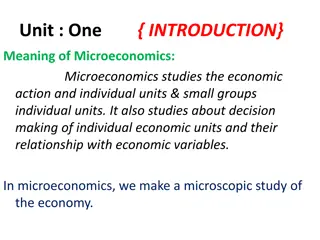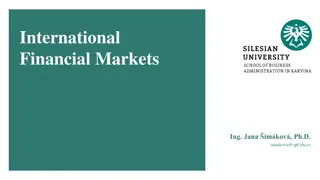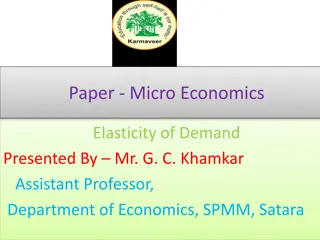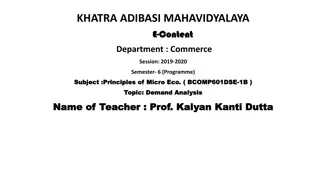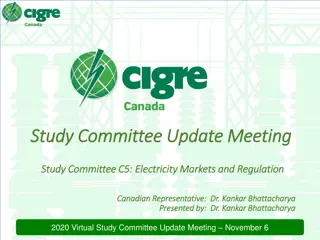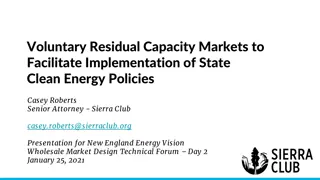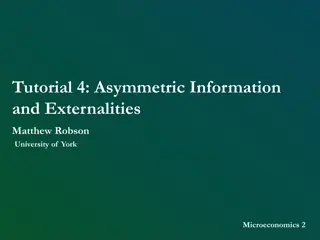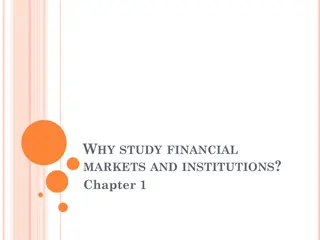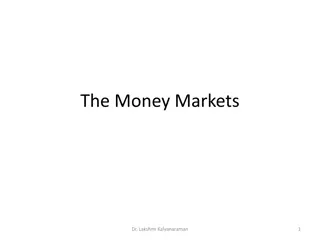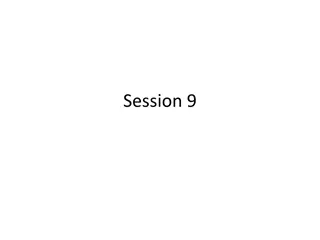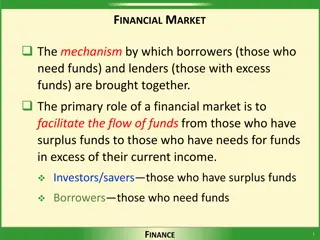Understanding Dynamics of Perfect Markets in Microeconomics
Explore the dynamics of perfect markets in microeconomics through this presentation by Mrs. L. Booi. Learn about the short and long run production, cost and revenue curves, and the concepts of perfect markets and imperfect markets. Gain insights into how things behave and affect other markets in the context of microeconomics.
Download Presentation

Please find below an Image/Link to download the presentation.
The content on the website is provided AS IS for your information and personal use only. It may not be sold, licensed, or shared on other websites without obtaining consent from the author. Download presentation by click this link. If you encounter any issues during the download, it is possible that the publisher has removed the file from their server.
E N D
Presentation Transcript
UMHLOBO WENENE PRESENTATION 26 MAY 2020 TOPIC: MICROECONOMICS Dynamics of Perfect Markets Presented by: Mrs L Booi CES: FET Curriculum Planning
OVERVIEW MICRO ECONOMICS FORMS PART OF ECONOMICS PAPER 2 &CONSISTS OF 3 SUB TOPICS PERFECT MARKETS IMPERFECT MARKETS MARKET FAILURES FORMS PART OF QUESTION 2, QUESTION 4 AND QUESTION 5 IN THE QUESTION PAPER Dynamics in this context refer to the way in which things (perfect markets) behave, react and affect other markets. (Adapted from Longman Dictionary of Contemporary English)
SHORT & LONG RUN/TERM Production takes place in the short run and the long run Short run Description: The short run is the period of production where only the variable factors of production can change. Variable factors of production are those that do change with output. Examples include labour, energy, raw materials directly used in production Long run Description: The long run is the period of production where all factors can change. The time is long enough for variable and fixed factors to change. It allows enough time for new firms to enter the industry and/or existing firms to exit. NOTE: Make sure you understand the difference between short and long run as these will be used in the discussions on Perfect and Imperfect markets. .
REVIEW OF COST AND REVENUE CURVES COSTS SHORT RUN COSTS TOTAL COSTS Description: Total cost (TC) is the sum of fixed and variable costs. Formula: Total cost = Fixed Cost + Variable Cost (TC = FC +VC) Total costs will be different for each unit produced, because variable costs change with each unit produced. Variable Costs/ direct costs/prime costs Description: Variable Costs (VC) are costs that change with the number of units produced. They increase as quantity increases. HOW? When a bakery produces one cake, it will use two eggs, but when it produces 100 cakes, it will use 200 eggs.
REVIEW OF COST AND REVENUE CURVES continued Examples: payments for labour ( wages), electricity, raw materials NOTE: Salaries are not regarded as an example of variable costs. Do not confuse with the commonly used term wages and salaries Fixed Costs/ indirect costs/Overheads Description: Fixed costs (FC) are costs that do not change with output. They remain the same even when the number of units produced changes. Fixed costs remain constant in the short run. HOW?- If a businesswoman rents a factory to produce cool drink bottles, she will pay the same amount of rent whether she produces 100 bottles or 10 000 bottles a month. Examples: rent, insurance premiums, depreciation
REVIEW OF COST AND REVENUE CURVES continued All the different costs to be discussed can be represented in a cost schedule/table.( insert a table) The costs can also be presented using curves. (Insert graphs) The shape of the cost curves is very important. The fixed cost curve is a horizontal line, because fixed costs stay the same for all quantities. The variable cost curve begins at 0 (there are no variable costs at zero units produced), slopes upwards from left to right and more sharply at the last quantities produced. The total cost curve begins on the horizontal line of the fixed cost curve (FC) because at zero units, the only costs are the fixed costs. It has the same shape as the VC curve.
REVIEW OF COST AND REVENUE CURVES continued TOTAL COST 60 TC 50 VC 40 COSTS 30 20 FC 10 0 0 1 2 3 4 5 6 QUANTITY
REVIEW OF COST AND REVENUE CURVES continued AVERAGE COSTS (AC/ATC) Description: Average costs are costs per unit of production. Formula: Total cost divided by number of units (AC = TC Q) This shows what it costs in total to produce each unit. Average Fixed Cost (AFC) = FC Q Average Variable Cost = VC Q MARGINAL COSTS (MC) Description: Marginal cost is the additional cost of producing one more unit of a product. Marginal cost is the amount by which total cost increases when one extra product is produced. Formula: MC = TC Q ( is read as change which is the difference between two items)
REVIEW OF COST AND REVENUE CURVES continued The marginal cost is important because it shows whether a business must produce more or fewer units of a product. (to be discussed under profit maximisation) AVERAGE AND MARGINAL COSTS MC 16 14 12 10 ATC/AC COSTS 8 AVC 6 4 AFC 2 0 1 2 3 4 5 6 7 QUANTITY
REVIEW OF COST AND REVENUE CURVES continued AFC slopes downwards from left to right. This is because its value decreases for each unit. AVC is roughly U shaped. It first decreases and then increases. ATC/AC the ATC has the same U shape as the AVC curve. The ATC/AC will always be above the AVC curve because the ATC is the sum of the AFC and AVC. MC first slopes downwards sharply, then gradually slopes upwards because it is a change in total costs. ( A tick).The MC curve begins at the same place as the AVC curve.
REVIEW OF COST AND REVENUE CURVES continued Long run costs A long run cost curve is created by putting together all short run cost curves over the time period. How do you differentiate between a short run and long run curves? Long run cost curves are flatter than short run cost curves. Example, the shape of the short run Average Cost curve (SRAC) is U- shaped (or shaped like a smile). The LRAC is flatter ( a more open smile) than SRAC. the Long run MC will be a flatter J. Secondly, differentiation is done by labelling the curves short or long run. SRAC, which stands for Short Run Average Cost and LRAC, Long Run Average Cost
REVIEW OF COST AND REVENUE CURVES continued SUMMARY OF REVENUE CURVES AND CALCULATIONS FOR PERFECT MARKET TOTAL REVENUE (TR) Description - Total revenue is the total income received from the sale of goods or services Formula Total revenue (TR) = Price (P) x Quantity (Q) The more units a business sells, the more total revenue it earns. AVERAGE REVENUE (AR) Description - Average revenue refers to the amount a firm earns for every unit sold. Formula Average Revenue (AR) = Total revenue (TR) Quantity (Q) For a perfect market, AR is equal to price because every unit is sold at the same price.
REVIEW OF COST AND REVENUE CURVES continued MARGINAL REVENUE (MR) Description Marginal revenue is the additional income received from selling one more unit of a product. It is the difference between two consequent (one following the other) total revenues. Formula - MR = TR Q (read as change in total revenue divided by change in quantity) TAKE NOTE The TR curve for a perfect market slopes upwards from left to right as more units are sold. The AR curve for a perfect market is a horizontal line at the Price (P= 25) The MR curve for a perfect market equals the AR curve and therefore a horizontal line at the Price ( P= 25)
REVIEW OF COST AND REVENUE CURVES continued PERFECT COMPETITION This is an essay type question. When answering the question, please note: Structure of the essay, which is always given in the question paper, Section C. Introduction: as you will see, describing the market structures (perfect and imperfect) involves the characteristics. When you answer in an essay, WRITE ONLY ONE OR TWO CHARACTERISTICS IN YOUR INTRODUCTION, to avoid repetition and losing marks in the main part of the essay.
TIPS ON DRAWING OF GRAPHS DRAWING OF GRAPHS Start by drawing the Revenue curves. Then draw the AC curve followed by the MC why? Drawing of the MC curve in relation to the AC curve. This tends to distort the interpretation of the graph. the technical aspects need to be remembered, e.g. the correct shape, positioning and labelling of cost and revenue curves in the perfect and imperfect markets. Practise step by step drawing of the cost and revenue curves. Correctly label each step as you draw. Emphasis must be placed on the average cost curve (i.e. smile ) which must always be drawn before the marginal cost curve (i.e. tick ). This will ensure that the MC always intersects the AC at its minimum point.
TIPS ON DRAWING OF continued Focus on the equilibrium position/point of the firm, where MR = MC which determines the profit or loss position of a firm. This point is regarded as the profit maximising point in the case of economic profit, a break even point in the case of normal profit and loss minimising point in the case of economic loss. The explanation of the graph should follow the basic steps irrespective of which market structure is involved. Identify profit maximising/loss minimising point first (MR = MC). This is most important as it impacts on all other variables in the explanation. The price and quantity should be determined. Note that in an imperfect market a line must be extended upwards from profit maximizing point to the demand curve to read off th eprice.
TIPS ON DRAWING OF GRAPHScontinued The next step is to compare AR (price) to AC to determine whether economic profit, economic loss or normal profit is made. Indicate the total economic profit from the graph. This could take the form of labels or a calculation. Profit and loss calculations. There is confusion in the application of the formula, Profit = TR TC. Be careful on how you present your final calculations. A figure showing loss must be accompanied by a negative sign. If it appears without the negative sign, then the word loss should accompany the figure. The equilibrium position could then be classified as short term or long term or both.
CONCLUSION YESTERDAY IS NOT OURS TO RECOVER, BUT TOMORROW IS OURS TO WIN OR LOSE LYNDON B JOHNSON
